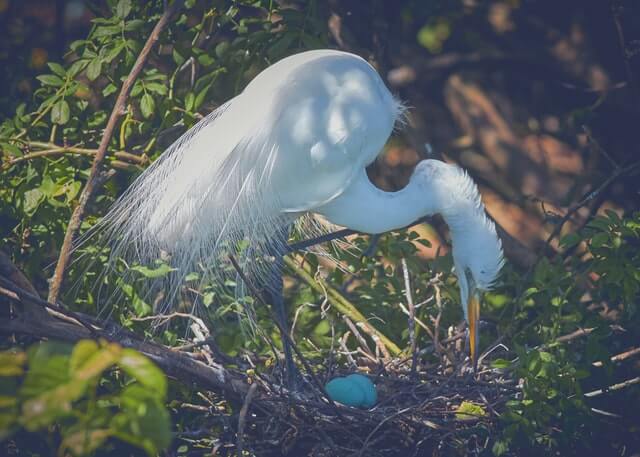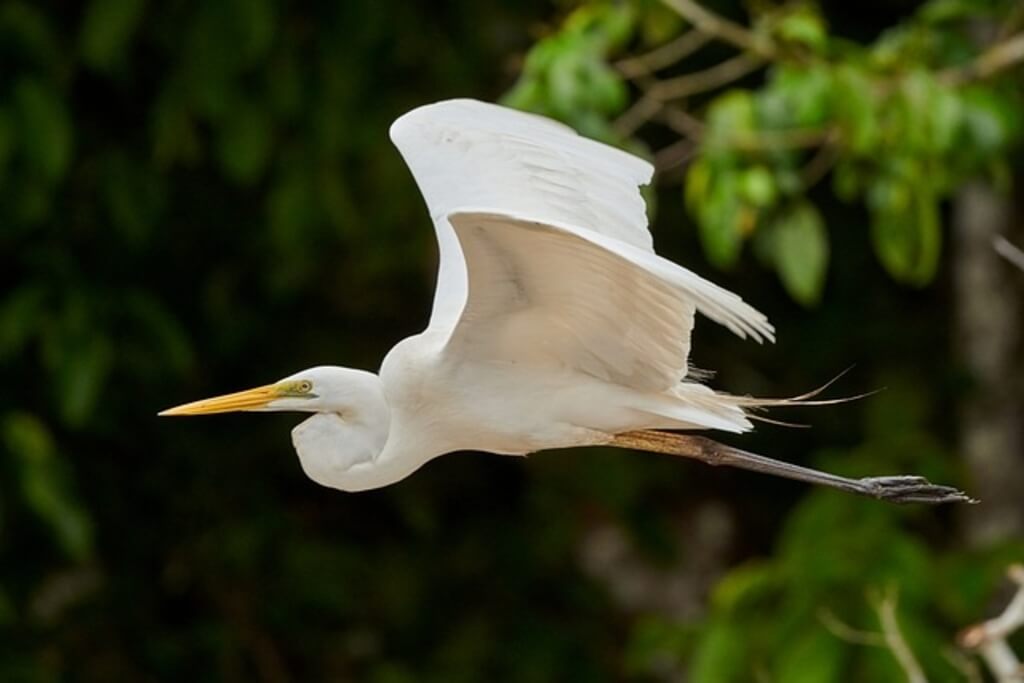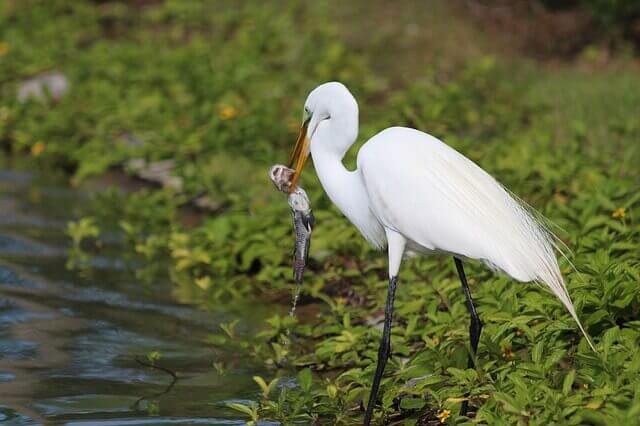Whether you’ve glimpsed these majestic birds in your local wetlands or witnessed their grace in the untamed wilderness, prepare to embark on an exhilarating journey of discovery. We present to you 65 captivating Fun Facts About Great Egrets, accompanied by stunning photos, comprehensive identification details, and in-depth insights. From their elegant presence in your neighborhood to their natural habitat in the wild, join us in unraveling the wonders of Great Egrets.
Table of Contents
Great Egret (Overview)
Fun Facts About Great Egrets
| Characteristics | Description |
|---|---|
| Identification | Great Egrets are large, dainty white water birds with an elegant appearance. They stand about 1 meter tall and have long, S-curved necks, pointed wings, long black legs, long slender toes for spearing fish, and a long sharp yellowish-orange dagger-like bill. |
| Adult Length | 3.4 feet (37.0 – 41.0″ in). |
| Adult Weight | 1.5 – 3.3 lbs. (24.0 – 52.8 oz). |
| Wingspan | 4.3-4.8 feet (51.6 – 57.1″ in). |
| Taxonomy | Order: Pelecaniformes, Family: Ardeidae, Genus: Ardea, Species: A. alba, Binomial Name: Ardea alba, Scientific Name: Ardea alba. |
| Distribution Range | Found mainly in North America and Europe, parts of Africa and Asia, and some regions of South America. |
| Habitat | Typically, near water with abundant vegetation like marshes, swamps, shallow ponds, or flooded fields. |
| Diet | Mainly fish, but also includes insects, reptiles, amphibians, crustaceans, and occasionally small mammals. |
| Lifespan | In the Wild: 15 years of age; In Captivity: 23 years of age. |
| Population | North American Population: Estimated 200,000 individuals; Europe Population: Estimated 70,000 individuals; Global Population: Estimated 2.2 million individuals. |
| Conservation Status | IUCN Red List (Listed Least Concern). |
| Range of Occurrence | Approximately 346,000,000 km2. |
| Nesting Behavior | The male Great Egret builds a nest near water, high up in trees or shrubs, and performs elaborate courtship displays, including regurgitating food for the mate. The nest is about 3 feet long, 1 foot wide, made of twigs and sticks, and lined with plant materials. Both parents incubate the eggs for 28 days. |
| Incubation Length | 23–27 days. |
| Nestling Length | 21–25 days. |
| Clutch Size | 1–6 eggs. |
| Number of Broods | 1–2 Broods per year. |
| Egg Description | Light blue in color and smooth. |
- Global Distribution: Great Egrets, a type of heron, can be found on every continent except Antarctica. They inhabit regions across Europe, Asia, Africa, North America, and South America. In the United States, they are observed from Maine to Florida to California.
- Impressive Flight Speed: In flight, the Great Egret has been recorded at speeds of up to 31 mph (50 km/h), outpacing similar-sized birds like the Little Blue Heron (18.5 mph) and Black-crowned Night-Herons (25 mph).
- Size and Widespread Range: The Great Egret is North America’s second-largest heron, following the Great blue heron. It’s also one of the most widely distributed birds globally, frequently spotted near wetlands, coasts, and gardens within its range.
- Life Expectancy and Predators: Great Egrets can live up to 15 years in the wild, though survival past 5 years is rare due to various predators such as other herons, snakes, raccoons, cats, and dogs.
- Nocturnal Feeding: These birds often feed at night or during low-light conditions, minimizing disturbance to other diurnal animals using the same areas for feeding or nesting.
- Monogamous Bonds: During each breeding season, Great Egrets form seasonally monogamous pairs. Males and females bond for the duration of their stay in the breeding area, which is typically an estuary or salt marsh.
- Feeding Behavior: Great Egrets are commonly seen standing in water or walking on land as they search for food. They wade through shallow water while stalking prey, waiting for the opportune moment to pounce.
- Longevity Record: The oldest-known documented Great Egret was banded in Ohio reached an impressive age of 22 years and 10 months.
- Impressive Wingspan: These birds boast a wingspan of up to 2 meters, making them the largest among white egrets.
- Diverse Diet: Great Egrets predominantly feed on fish, frogs, snakes, reptiles, insects, and crustaceans. They use their long legs to stalk prey slowly in shallow waters.
- Nesting Preferences: They commonly nest near bodies of water, including lakes, ponds, or estuaries. They may nest individually or alongside other heron or egret species. While they typically nest in trees, they will use man-made structures when natural options are scarce.
- Scientific Name: The Great Egret’s scientific name is Ardea alba.
- Genus Diversity: There are fourteen other species in the genus Ardea.
- Sexual Dimorphism: Male and female Great Egrets appear identical in appearance, with size being the only distinguishing factor. Males are slightly larger than females.
- Chick Terminology: Young Great Egrets are called “Hatchlings.”
- Developmental Milestones: Hatchlings typically leave the nest at three weeks of age and achieve flight capability by six weeks of age.
- Collective Nouns: A group of egrets is associated with various collective nouns, including a “wedge” of egrets, “congregation,” “heronry,” “skewer,” and “RSVP.”
- Taxonomic History: Initially identified by the scientific name “Ardea alba” in 1758 by Carolus Linnaeus.
- Family Relations: Great Egrets are closely related to other large herons, including the Snowy, Intermediate, and Cattle Egrets.
- Protected Status: The Great Egret is a species protected under the Migratory Bird Treaty Act of 1918.
- Seasonal Migration: In colder regions, Great Egrets undertake seasonal migrations, moving south for the winter.
- Omnivorous Diet: Great Egrets exhibit an omnivorous diet, consuming both meat and plant matter.
- Cold Weather Limitation: Their lack of heavy insulating feathers prevents them from surviving in cold weather.
- Conservation Concerns: The Great Egret population faces numerous threats, including habitat destruction, overfishing, pesticide use, and oil spills, emphasizing the importance of conservation efforts to preserve ecosystems.
- Ecological Significance: Preserving the Great Egret’s population is crucial for maintaining the health and balance of natural ecosystems.

- Breeding Plumage: During the breeding season, Great Egrets develop beautiful long plumes on their backs, which were once highly prized for making hats. This led to a significant decline in their population until protective laws were enacted.
- Courtship Displays: Great Egrets engage in elaborate courtship displays, including aerial acrobatics, synchronized movements, and mutual preening, to strengthen their pair bonds.
- Migratory Behavior: While some populations of Great Egrets are migratory, others are sedentary, staying in their breeding areas year-round. Migration patterns can vary depending on the region.
- Communication: These birds use various vocalizations and body language to communicate with each other. Their vocal repertoire includes soft clucks and squawks in addition to their loud calls.
- Nest Material: Great Egrets use sticks, reeds, and other vegetation to build their nests. They often return to the same nesting site year after year, adding to the existing structure.
- Parental Care: Both parents take turns incubating the eggs and feeding the chicks. They regurgitate food into the chicks’ mouths during the early stages of development.
- Elegant Plumage: Great Egrets are known for their elegant, all-white plumage, which is in stark contrast to their striking black legs and yellow bills.
- Breeding Range: While they are known to breed in a variety of wetland habitats, Great Egrets have also been observed nesting on small islands and even in urban areas.
- Fishing Techniques: When hunting for fish, they employ a patient and stealthy approach. They use their sharp beaks to spear their prey quickly.
- Protective Eyelids: Great Egrets have a nictitating membrane, also known as a third eyelid, which helps protect their eyes while they’re hunting in water.
- Social Behavior: These birds are often seen foraging in groups, especially in prime feeding locations. The collective action can help them herd fish toward shallower waters.
- Feeding Frenzies: Great Egrets are known to participate in feeding frenzies with other wading birds, especially during times of abundant prey. This behavior allows them to capitalize on the availability of food.
- Territorial Defense: They are known to defend their nesting territories vigorously against intruders, including other Great Egrets and wading bird species.
- Predatory Threats: While Great Egrets are skilled predators themselves, they may fall prey to larger birds of prey, such as eagles and owls.
- Life Cycle: Their life cycle includes stages of courtship, mating, nesting, chick rearing, and migration if applicable. Each stage is marked by specific behaviors and adaptations.
- Ecosystem Services: Great Egrets play a vital role in controlling populations of aquatic organisms like fish and amphibians. This helps maintain the balance of wetland ecosystems.
- Wetland Health Indicator: The presence and population health of Great Egrets can serve as indicators of the overall health of wetland habitats.
- Conservation Efforts: Many organizations and governments work to protect Great Egret populations and their habitats, recognizing their ecological importance.
- Global Distribution: Great Egrets have a broad global distribution, making them an essential component of wetland ecosystems on multiple continents.
- Adaptability: These birds have demonstrated adaptability by nesting in some unexpected places, like man-made structures, when natural nesting sites are scarce.
FAQs:
Are great egrets aggressive?
Great egrets can be aggressive and very territorial birds, that will often attack other animals that come into their territory. This is especially true in nesting season, which usually lasts from April through August.
What animals eat great egrets?
There are many natural predators to Great Egrets, including raccoons, foxes, coyotes, eagles, hawks and other large birds of prey.
Where do egrets sleep at night?
Egrets also like to roost at night by sleeping standing up with one foot in the water and their head tucked under a wing. They stay alert, even when they sleep. This allows them to keep an eye out for predators or prey.
Do egrets live alone?
Egrets have been known to congregate with other egret species during breeding season, but otherwise they lead solitary lives, and prefer to spend their time alone or with a mate. The fact that they’re solitary might seem strange, but it actually makes sense when you look at the birds’ nesting habits.
Do great egrets eat snails?
One might think that Great Egrets just eat fish or insects, but in fact their diet also consists of invertebrates such as snails and crayfish. They are actually known to be one of the most prolific predators on land for slugs and snails.




